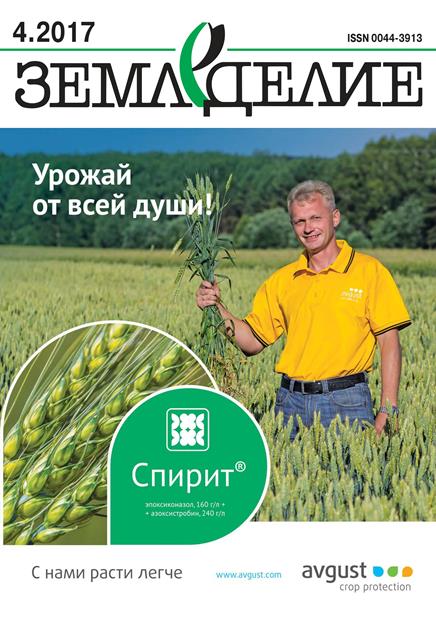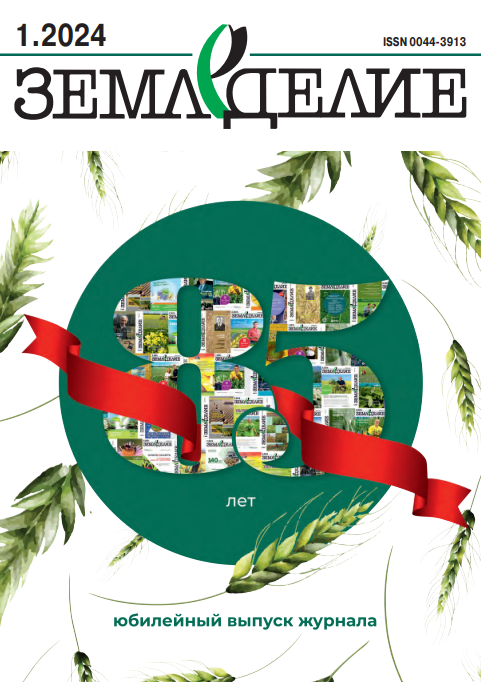Влияние темпов разложения растительных остатков на лабильное органическое вещество почвы и урожайность культур севооборота
Земледелие, 2017, № 4
УДК 631.45:631.153.3:651.95
А.А. ДЕДОВ, аспирант
М.А. НЕСМЕЯНОВА, кандидат сельскохозяйственных наук, ассистент
Адрес электронной почты защищен от спам-ботов. Для просмотра адреса в вашем браузере должен быть включен Javascript.
А.В. ДЕДОВ, доктор сельскохозяйственных наук, зав. кафедрой
Воронежский государственный аграрный университет им. императора Петра I, ул. Мичурина, 1, Воронеж, 394087, Российская Федерация
В условиях беспрерывного возделывания культур важную роль в регулировании плодородия почвы играют послеуборочные растительные остатки, ценность которых зависит не только от массы и химического состава, но и от скорости разложения. С целью определения скорости разложения послеуборочных остатков и ее влияния на динамику содержания лабильного органического вещества и детрита в почве, а также на урожайность возделываемых культур на кафедре земледелия Воронежского ГАУ был заложен многофакторный стационарный опыт. Исследования проводили в 2013-2015 гг. в четырехпольном звене севооборота: пар (чистый, сидеральный, занятый) – озимая пшеница – ячмень (пожнивной посев редьки масличной и горчицы белой на сидерат) – кукуруза на зерно/ подсолнечник с подсевом многолетних бобовых трав (донник желтый, люцерна синяя). Почва опытного участка – чернозём типичный глинистый среднемощный: содержание гумуса в пахотном слое почвы 5,3 %, сумма обменных оснований – 34,1 мг-экв/100 г, подвижных фосфора и калия (по Чирикову) – 113 и 184 мг/кг почвы соответственно, гидролизуемого азота – 62,9 мг/кг почвы. Процессы разложения растительных остатков сельскохозяйственных культур наиболее интенсивно протекали в звеньях севооборота с многолетними бобовыми травами. Степень разложения растительной массы в этих вариантах была на 15,4-17,9% выше, чем при возделывании культур без использования приемов биологизации. Возделывание многолетних бобовых трав (донника желтого и люцерны синей) в изучаемом севообороте позволило обеспечить формирование запасов детрита в 1,7-2,0 раза выше, чем в контроле. На фоне уменьшения к концу ротации контрольного звена севооборота содержания в почве гумуса, возделывание многолетних бобовых трав обеспечило его сохранение на исходном уровне. Применяемые приемы биологизации способствовали увеличению урожайности подсолнечника (на 0,10-0,28 т/га) и дополнительному получению в поле занятого пара зеленого корма люцерны синей (12,38 т/га).
Ключевые слова: растительные остатки, разложение, детрит, гумус, многолетние бобовые травы, урожайность.
Для цитирования: Дедов А.А., Несмеянова М.А., Дедов А.В. Влияние темпов разложения растительных остатков на лабильное органическое вещество почвы и урожайность культур севооборота // Земледелие. 2017. № 4. С. 6-9.
Influence of Decomposition Rates of Plant Residues on Labile Organic Matter of Soil and Crop Yield in a Rotation
A.A. Dedov, M.A. Nesmeyanova, A.V. Dedov
Peter I Voronezh State Agrarian University, ul. Michurina, 1, Voronezh, 394087, Russian Federation
Under conditions of continuous cultivation of crops post-harvest plant residues play an important role in regulating soil fertility; and their value is determined not only by their mass and chemical composition, but also by the rate of decomposition. In order to determine the rate of decomposition of plant residues and its influence on the dynamics of content of labile organic matter and detritus in the soil, as well as on the productivity of cultivated crops a multifactor stationary experiment was laid down by the department of agriculture of Voronezh State Agrarian University. The investigations were carried out in 2013-2015 in a four-field crop rotation link: fallow (bare, green manure, seeded), winter wheat, barley (with afterharvest sowing of oil radish and white mustard for green manure), corn for seed/sunflower with undersow of perennial legumes (yellow melilot, purple alfalfa). The soil of the plot was typical chernozem, clayey, medium-thick. The content of humus in the arable layer was 5.3 %; S-value was 34.1 mg eq/100 g; the content of mobile phosphorus and potassium (by Chirikov) and hydrolysable nitrogen was 113, 184, and 62.9 mg/kg of soil. The processes of plant residues decomposition of agricultural crops proceeded most intensively in the links of the crop rotation with perennial legumes. The degree of decomposition of the plant mass in these variants was higher by 15.4-17.9 % than in the case of cultivation of crops without biologization methods. The cultivation of perennial legumes (yellow Melilot and purple alfalfa) in the studied crop rotation allowed the formation of reserves of detritus 1.7-2.0 times higher than in the control variant. Against the background of decrease in the content of humus in the soil by the end of the control link of the crop rotation, the cultivation of perennial legumes ensured its preservation on the initial level. The utilized biologization methods resulted in the increase in the yield of sunflower (by 0.10-0.28 t/ha) and an additional amount of green forage of purple alfalfa produced in the field of seeded fallow (12.38 t/ha).
Keywords: plant residues, decomposition, detritus, humus, perennial leguminous grasses, productivity.
Author Details: A.A. Dedov, post graduate student; M.A. Nesmeyanova, Cand. Sc. (Agr.), assist. (e-mail: marina-nesmeyanova2012@ yandex.ru); A.V. Dedov, D. Sc. (Agr.), head of department.
For citation: Dedov A.A., Nesmeyanova M.A., Dedov A.V. Influence of Decomposition Rates of Plant Residues on Labile Organic Matter of Soil and Crop Yield in a Rotation. Dostizheniya nauki i tekhniki APK. 2017. Vol. 31. No. 4. Pp. 6-9 (in Russ.).










